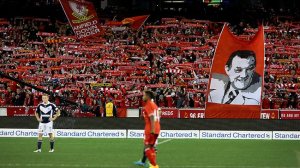As the silly season (the off-season and transfer window, where there is nothing to do but follow up rumors and speculation) continues, many of the big teams have embarked on their pre-season friendly tours scattered across the globe. These tours give the new squad a chance to play together, young prospects to stand out, and everyone to shake off the rust of a whole month off from the game. The popularity of these games leads to speculation that the EPL is still looking at a 39th game – extending the season by a week and having the teams play a game overseas that might actually mean something. Judging by the amount of money these pre-season tours can pull in for some teams, it’s not surprising that fans in England are worried. Consider the £1,000,000 fee that Liverpool missed out on in May because a potential friendly in Cape Town conflicted with South African league rules. And here in Toronto, the terrible TFC team that seems too exhausted to play a full 90 minutes most weeks is now stuck playing a mid-week friendly vs AS Roma (Aug. 7).
Beyond the financial and player management reasons for doing these tours, most of the teams that spend the pre-season travelling do so to expand their fan base (yes, there are financial reasons for that too). These tours may provide overseas fans their only chance to see their team in action – even if most of the first team gets subbed off after 45 minutes. Which then plays in to that old divide of who are the “authentic” fans: those that are from said team’s home town and live and breathe that team, or those fans that despite the distance separating them from their team, still find themselves connected to that distant team?
In a simple world people would all be fans of local teams, but of course the world is not that simple. People become fans of teams around the world for various reasons:
- the fan originates from the distant team’s city (I cheer for the Calgary Flames – even if I haven’t lived in Alberta for 30 years).;
- the fan’s family has connections to the team’s city;
- the fan follows a specific player (how many Messi jerseys are sold on that basis alone);
- the fan actually enjoys the way a team plays (I originally started following Arsenal for this reason);
- the fan can have any number of other reasons, but the above are just a few that occurred to me.
Regardless of the reason, once hooked on a team the individual becomes a fan, often in a way similar to how Nick Hornby describes it at the beginning of Fever Pitch, “suddenly, inexplicably, uncritically, giving no thought to the pain or disruption it would bring with it.” If you’ve seen the tears of a young boy as his team (Barcelona) gets thumped by Bayern Munich, you’ll understand the suffering can be there even in the most distant fans. In fact, there is something more desperate to the distant fan, as they have been given multiple chances to turn aside, cheer for a closer team, watch a different sport, but they have chosen to stick with their far away team. They will sacrifice a Saturday morning sleep-in to get to the pub for the 7:30 AM kickoff. And if their team should happen to come to town, well, that could just be the moment of their life.
So it is no surprise that one of the videos that keeps popping up over the last few days is from Liverpool’s stop in Melbourne to play the Melbourne Victory. As I expected, the Victory were not the home team, just as Toronto FC was not the home team at Rogers Centre last year. Instead, the stadium was filled to its 95,000 seat capacity with the red of Liverpool – Liverpool was also playing in their “home” red kit. The Melbourne Cricket Ground became Anfield for the day. And no Liverpool performance would be complete without the anthem, perhaps the largest single crowd to ever sing You’ll Never Walk Alone – at least since the terraces disappeared, as the 95,000 capacity is more than double the size of Anfield. Local hotels reported 100% occupancy, an audience of 1 million Aussies watched the game, and the visit generated about $10 million AUD for the local economy.
While the experience of the game and its uniqueness for locals has the fans back in England worried, I doubt the 39th game will come to pass. The current system where the teams can use it as their pre-season tour is an ideal way to generate money for the team and to shake the squad out with minimal personnel risk (these are friendlies, and rarely do the big stars play the full game – and sometimes they don’t even suit up). With familiarity breeds if not contempt, at least indifference. How do you decide where to play the 39th? Who becomes the home team? Do they play there every season? How many foreign fans will pay to watch Crystal Palace vs Hull? The massive appeal of the EPL is actually concentrated in just a handful of teams, meaning that for every raucous rendition of You’ll Never Walk Alone, you’ll get a confused and silent crowd as Z Cars plays.


